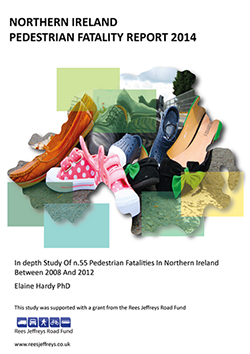 20 MPH Speed Limits At The Northern Ireland Assembly
20 MPH Speed Limits At The Northern Ireland Assembly
Previously we have reported on a Private Members’ Bill – Road Traffic (Speed Limits) Bill – being introduced at the Northern Ireland Assembly.
On Tuesday of this week this bill when through its second stage to go forward to Committee Stage due on the 15th April 2015.
The committee responsible will look at the bill in more depth.
The basics of the Bill is to set a maximum speed limit on residential roads of 20 miles per hour – whether this is a blanket enforcement or where residents along with all agencies (a stakeholder led approach e.g. the local community – police – public transport service – young people), feel that a 20mph zone would be beneficial in terms of road safety is up for further discussion – for amendments to be tabled as the bill progresses.
At some stage we believe this will also include a full public consultation.
If you read the latest debate in the Northern Ireland Assembly – you will read what has been described in the debate as “devilment” in engaging with other members (politicians) – and big words such as “facetiousness” – you will read about concerns that the bill, “for many people might be not a Road Traffic (Speed Limits) Bill but a “horse – and – cart Bill” – then read past what you would expect from a debate and read the thoughts and reasoning behind the proposed bill.
The thoughts and reasoning includes the aim of reducing casualties on residential street which concerns vulnerable road users such as young and old pedestrians and cyclists and during the debate various politicians offered up varied figures on fatal road collisions, where and how, speeds and examples of other 20 mph limits that have been introduced in the rest of the UK but there did not seem to be any thoughts on why these fatalities happen.
Northern Ireland Pedestrian Fatality Report 2014
 In 2014 the Northern Ireland Pedestrian Fatality Report 2014 was published by Elaine Hardy PhD, the other half at Right To Ride, the report followed on from a similar report regarding motorcycle fatalities.
In 2014 the Northern Ireland Pedestrian Fatality Report 2014 was published by Elaine Hardy PhD, the other half at Right To Ride, the report followed on from a similar report regarding motorcycle fatalities.
The pedestrian fatality report is an examination of n.55 collision scene reports of pedestrian fatalities between 2008 and 2012 and looks in-depth at the why.
Over the five year period between 2008 and 2012, investigators from the Road Traffic Collision Investigation Unit attended road traffic fatalities in Northern Ireland analysing collision scenes the report with findings of these reports supported by Coroners’ Verdicts:
- In n.30 (55%) of cases the pedestrians wore dark clothing.
- The majority of collisions occurred in darkness n.35 (64%), while the remaining n.20 (36%) collisions occurred during daylight.
- In n.50 (91%) of the incidents, the vehicle was not driven at excessive speed (over the speed limit).
- Children aged between one to 16 years represented the smallest group (12.7%); the group representing adults (including one 17 year old) total n.31/55 (56.4%) of the fatalities.
- There were n.17/55 (31%) elderly pedestrians (aged over 70 years) involved in collisions with vehicles. In n.5 cases, the elderly pedestrians (n.2 females and n.3 males) crossed the road in front of a lorry.
- There were n.17/55 pedestrians (31%) who were found to have alcohol in their blood at the time of the collision. All n.17 cases occurred during the hours of darkness. The average Blood Alcohol Content was 232 mg per 100 ml.
The reasoning behind introducing 20 mph zones makes interesting reading as does the findings from the report that support the proposition that:
- The visibility of drivers can be impaired due to darkness and glare, this is compounded due to the dark clothing of pedestrians which inhibits the drivers to discern them in darkness.
- The elderly are vulnerable road users because of their frailty and at times inability to understand speed and distance.
- Intoxicated pedestrians are a danger to themselves because of the levels of alcohol ingested which cause these pedestrians to be unstable and incoherent.
Powered Two Wheeler (Motorcycle – Scooters – Mopeds) users are also recognised as vulnerable along with pedestrians and cyclists. All these vulnerable road users need to think very carefully what they are all doing out there on our roads.
As motorised road users we can look after the more vulnerable road users through anticipation, appropriate speed, awareness of road conditions, weather conditions, difference in rural and urban driving/riding.
We must remember that a vulnerable road user hit at 20mph is still a human being who is involved in possible live changing injuries or death, in that respect, the aim should be to reduce collisions and injuries rather than reduce speed limits per se.
As one MLA said in the debate, “One of the key issues is changing the practical attitudes of people and how they respect other road users, whether they are drivers, pedestrians or cyclists We look forward to watching the progress of this bill.” and we would add riders of Powered Two Wheelers giving and taking respect on our roads.
Links & Information
Session 2014 – 2015 Official Report (Hansard) Tuesday 17 February 2015 Volume 102, No 2 – pdf – Click Here
Start at Page 17 – Then again at Page 41 we think it is a good read.
NIA Bill 30/11-15 Road Traffic (Speed Limits) Bill – Click Here
NI Pedestrian Fatality Report 2014 – Click Here
Read our previous thoughts – Click Here



This government in the UK has adopted the 20 is plenty speed limit to be in place before 2020 in order to comply with the European aimes, requirements and obligations to reduce traffic injuries and deaths by that year 2020. Prior to that it was the previous government that spent billions on speed cameras only to find in retrospect that now that many are obsolete and no longer in use they have made not a scrap of difference in the incident/collision rates.
So this is once more a political expediency rather than a Road safety concern. There is an organisation of reputed registered charitable nature that is receiving monies from a variety of Government and Local authorities and other allied institutions that has been very vociferous in advocating the implementation of this endeavour.
Whichever authority undertakes this initiative generally have within several months come out in favour of their actions. Now call me a cynic but if i were to spend millions of pounds on signage and passive measures to slow drivers down I would not exactly come out and admit that a mistake has been made. So one can see from that that wherever this intervention has been adopted the reports have been flavoured in favour of it. The truth being smudged to fit the positive aspects by those in power.
Further it appears to me that what this government was actually in favour of was a blanket cover of all villages towns and cities.. This would simply mean a 20 mph speed limit throughout any urban area including main arterial roads that may have been 30 or 40 mph previously. The costings of this intervention would simply be the placing of 20 mph at bounderies so if there were 10 roads in then only 20 signs would be required. Extremely cheap with no need of passive measures being lawfully required.
That has not happened and authorities have chosen to subject small residential areas within an urban area. This has cost a lot more monies as every in and out junction requires signage. they have also in places implemented passive measures, carpets, speed humps etc in order to force vehicles to slow down. This is also at additional expense. They are going about it piecemeal in order to frustrate drivers and as they continue to include more and more areas they presume that opinion will grow stronger by drivers and local residents alike for a total single speed limit covering the urban area in total. That speed limit being… obviously 20 mph.
This is in general the way that all authorities introduce something that they feel would not initially receive support from its residents. Many will make use of the smudged reports putting out the propaganda as mentioned before in order to justify the decision. Dubious reports from other authorities in support for the measures taken and foreseen statistics that show a possible decrease in accidents and injuries sustained to children and that it will make roads a safer place for children to play out and enjoy. etc. etc.
I hope that this article will help and illuminate many. Whilst it is still in its infancy some areas of England have had 20 mph areas for quite a few years and the statistics they put forward, as I have said, do not give a clear overall picture of reduced incidents being smudged in favour of the decision to support this initiative.